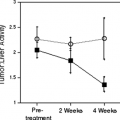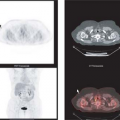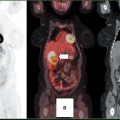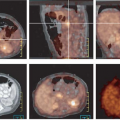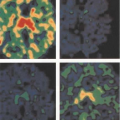PET and PET/CT in Ovarian Cancer
Hedieh Eslamy
Robert Bristow
Richard L. Wahl
Ovarian cancer accounts for about 3% of all cancers among women and ranks second in frequency among gynecologic cancers in the United States, following cancer of the uterine corpus (1). However, in the United States, ovarian cancer has the highest mortality rate of all gynecologic cancers. An estimated 22,430 new cases of ovarian cancer and an estimated 15,280 deaths are expected in the United States in 2007 (1). This high mortality rate is in part related to the relatively advanced stage of disease in which ovarian cancer patients often present (1). Given the rather late state at which ovarian cancers are frequently diagnosed, it is clear why there is a considerable interest in developing earlier diagnostic methods for ovarian cancer.
At present, most ovarian cancers are judged as “sporadic.” However, there are families at increased risk of ovarian cancer based on mutations in the BRCA1 or BRCA2 genes. It has been estimated that about 10% of ovarian cancers fall into this class of familial cancers. Relative risks of cancer of 20- to 45-fold over the general population have been described for carriers of these mutations. These same mutations are associated with markedly increased risks of breast cancer as well. Risk-reducing salpingo-oophorectomy has been applied in some of these women in an effort to reduce the probability of a new cancer developing (2).
Histologically, ovarian cancers are differentiated by the cell of origin: epithelial (90%), stromal, germ cell, or mixed the remainder. Ovarian cancer results in regional and distant spread through four main pathways:
Penetration of the ovarian capsule and direct invasion of contiguous organs or the pelvic peritoneum;
Spread via the lymphatic system to the pelvic and para-aortic lymph nodes;
Penetration of ovarian capsule and subsequent peritoneal spread;
The potential diagnostic tasks in ovarian cancer are several fold. First, accurate early diagnosis of ovarian cancer before it was clinically apparent as a pelvic mass or disseminated disease would be highly desirable. Second, characterization of an ovarian mass as malignant or benign, noninvasively, would be of great value. Once an ovarian mass was diagnosed as malignant, assessing the extent of disease would be very helpful as well (i.e., staging). After diagnosis and staging, predicting if a response would occur to a specific therapy or determining whether the disease is responding to treatment would also be very useful. Positron emission tomography (PET) has been evaluated in each of these settings to some extent, however, the role of PET must be considered in the context of other imaging and diagnostic approaches to ovarian cancer. PET has been most extensively evaluated in patients with known ovarian cancer, however.
Background: Primary Disease Detection
A robust method to screen for ovarian cancer has the potential to reduce mortality from this disease, much as has occurred with cervical cancer and the use of cytological staining. To date, a single modality screening method for ovarian cancer, using either the blood test for cancer antigen 125 (CA125) or transvaginal ultrasonography (TVS), has not provided the required accuracy necessary for reliable, cost-effective, early detection of this cancer. Multimodality screening using serum CA125 and pelvic or TVS appears to improve the median survival in the screened group (5,6,7,8). Currently there are at least two large ongoing trials for multimodal screening (CA125 and TVS) in ovarian cancer. The final assessment of the accuracy of such approaches will have to await the analysis of the complete cohort and longer follow-up to assess the impact on mortality (9,10). It is clear that such programs can identify patients with ovarian masses, which then need further work-up.
Most ovarian masses in premenopausal women are benign in etiology and functionally related to the menstrual cycle. When incidentally detected, these masses are typically followed for regression by physical examination or ultrasound. Those that do not regress have a great probability of malignancy. By contrast, ovarian masses in postmenopausal women are more commonly malignant in etiology and are far more concerning for cancer than masses in the premenopausal woman. Certainly, premenopausal women can develop
ovarian cancer and a mass that does not resolve in such a patient is of considerable concern for cancer and requires further work-up.
ovarian cancer and a mass that does not resolve in such a patient is of considerable concern for cancer and requires further work-up.
Morphologic imaging may be used to characterize adnexal masses as benign or malignant and delineate regional or distant spread prior to surgery. In a recent meta-analysis, Liu et al. (11) compared ultrasound (US), computed tomography (CT), and magnetic resonance imaging (MRI) in differentiation of malignant from benign ovarian tumors. Sensitivity and specificity estimates of all imaging modalities were comparable: 89% (95% confidence interval [CI], 88% to 90%) for US, 85% (95% CI, 83% to 86%) for CT, and 89% (95% CI, 88% to 92%) for MRI (P = .09). Specificity estimates were also comparable: 95% CI, 83% to 85% for US, 76% to 92% for CT, and 84% to 88% for MRI (P = .12). The authors concluded that ultrasound techniques seem to be similar to CT and MRI in differentiation of malignant from benign ovarian tumors, and that ultrasound morphologic assessment still is the most important and common modality in the detection of ovarian cancer. However, since none of these imaging methods achieve total accuracy, persistent ovarian masses in postmenopausal women are commonly surgically excised to avoid delayed diagnosis of ovarian carcinoma.
Staging
Traditionally, ovarian cancer has been staged surgically. The TNM (Tumor, Node, Metastasis) and FIGO (Federation Internationale de Gynecologie et d’Obstetrique) staging systems classify ovarian cancers as:
Stage I: tumor limited to ovaries (one or both)
Stage II: tumor involves one or both ovaries with pelvic extension
Stage III: tumor involves one/both ovaries with microscopic/ macroscopic peritoneal metastasis beyond the pelvis and/or regional lymph node metastasis
Stage IV: distant metastasis (excludes peritoneal metastasis) (12).
Essential elements of surgical staging of ovarian cancer include peritoneal cytology, intact tumor removal, complete abdominal exploration; removal of the remaining ovary, uterus, and fallopian tubes; infracolic omentectomy, pelvic, and para-aortic lymph node sampling; and multiple biopsies, including “blind biopsies” from areas at risk for spread (i.e., diaphragm, paracolic gutters, and pelvis). Prognosis is influenced by the diameter of the residual disease after primary cytoreductive surgery, with optimal and suboptimal debulking being defined as the largest diameter of a residual nodule as 1 cm or less or greater than 1 cm, respectively. Quite clearly, it is desirable to surgically reduce the tumor volume to the greatest extent feasible in such procedures (4).
Approximately 20% to 30% of patients with early stage disease (stage IA to IIA) and 50% to 75% of those with advanced disease (stage IIB to IV) who obtain a complete response following first-line chemotherapy will ultimately develop recurrent disease, which more frequently involves the pelvis and abdomen (13).
In a recent study preoperative CT and MRI were found to be reasonably accurate in the detection of inoperable tumor and in the prediction of suboptimal debulking (sensitivity, specificity, positive predictive value, and negative predictive value were 76%, 92%, 94%, and 96%, respectively). The two modalities were equally effective (P = 1.0) in the detection of inoperable tumor. This study suggests that imaging may help triage inoperable patients to a more appropriate neoadjuvant chemotherapy group (14). The 76% sensitivity indicates there are still major opportunities to improve imaging accuracy, especially for low tumor volume disease.
The standard of care for patients with ovarian carcinoma is primary cytoreductive surgery and adjuvant chemotherapy (the latter except in some stage IA and IB patients), typically intravenous paclitaxel and carboplatin. A number of phase III randomized trials in the United States have reported improved progression-free survival (PFS) and/or overall survival (OS) with the intraperitoneal (IP) administration of cisplatin. Hess et al. (15) identified six randomized trials of 1,716 ovarian cancer patients. The pooled hazard ratio (HR) for PFS of IP cisplatin as compared to intravenous treatment regimens reported was 0.792 (95% CI, 0.688 to 0.912; P = .001), and the pooled HR for OS was 0.799 (95% CI, 0.702 to 0.910; P = .0007), both favoring IP therapy to intravenous treatment. These findings strongly support the incorporation of an IP cisplatin regimen to improve survival in the front-line treatment of stage III, optimally debulked ovarian cancer.
Recently, a prospective trial by Armstrong et al. (16) showed in 415 patients enrolled that for the patients who could tolerate the rather toxic IP therapy approach, the median duration of PFS and OS were significantly prolonged in the IP therapy groups versus the intravenous PFS from 18.3 to 23.8 months and disease-free survival from 49.7 to 65.6 months (P <.03 and <.05, respectively).
In patients with advanced disease who are not candidates for primary cytoreductive surgery, neoadjuvant chemotherapy is commonly administered. Localized borderline histology tumors are sometimes not treated with chemotherapy.
Ovarian cancer primarily recurs in the peritoneal cavity and retroperitoneal lymph nodes. Patients are monitored for recurrence with periodic physical examinations, serum CA125 levels, and ultrasound examination. Additional imaging—CT, MRI, and fluorine 18-fluorodeoxyglucose ([18F]-FDG) PET, or PET/CT—is performed when signs or symptoms suggestive of recurrence appear (4,13,17). However, both morphologic (CT and MRI) and functional imaging ([18F]-FDG PET) are limited in their ability to detect small-volume (<5 to 10 mm) disease. Rising CA125 levels may precede the clinical detection of recurrence in 56% to 94% of the cases, with a median lead time of 3 to 5 months (13).
In the 1970s and 1980s, second-look surgery, defined as a comprehensive surgical exploration in an asymptomatic patient who has completed primary cytoreductive surgery and adjuvant chemotherapy, was widely used. Second-look surgery does not appear to have a role in the management of early stage ovarian cancer, and its role in the patients with advanced-stage disease is controversial (4).
The treatment options for recurrent ovarian cancer include salvage chemotherapy, experimental protocols, hormonal therapy, secondary cytoreductive surgery, palliative care, and hospice care. The choice of the chemotherapeutic regimen depends on whether the disease is platinum sensitive or platinum resistant. Patients with disease progression while receiving platinum-based therapy, patients who fail to achieve a complete clinical response, and those who relapse within 6 months of the end of chemotherapy are classified as platinum resistant (4,17).
Role of Fluorodeoxyglucose PET in Ovarian Cancer Imaging
Ovarian cancers have been shown to be FDG avid in animal models, to express high levels of the glucose transporter GLUT1, and in human xenograft studies to have higher FDG uptake in areas of viable cancer than in normal tissues (including normal lymph nodes) in human xenograft studies. Pilot studies showing the feasibility of imaging ovarian cancer
with PET were reported as early as 1991 (18,19,20). Nearly all PET imaging of ovarian cancer is currently performed with FDG as the radiotracer.
with PET were reported as early as 1991 (18,19,20). Nearly all PET imaging of ovarian cancer is currently performed with FDG as the radiotracer.
Much like other FDG-avid cancers, patients should be imaged in the fasting state to minimize insulin levels and the targeting of FDG to normal insulin-responsive tissues like skeletal muscle. The approach to imaging may vary slightly depending on the individual PET center but is generally rather consistent. In the authors’ institution, patient preparation for ovarian cancer imaging is similar to that for oncologic imaging in general, with fasting for at least 4 hours (and ideally overnight), with no specific urinary tract preparation. The authors normally use dilute positive oral contrast to achieve definitive positive bowel visualization. In some centers, various interventions are utilized to decrease the amount of FDG in the urinary tract such as bladder catheterization, continuous bladder irrigation, and/or intravenous hydration (1,000 to 1,500 mL of 0.9% or 0.45% saline solution) followed by the intravenous administration of 20 to 40 mg of furosemide. Another way to deal with urinary tract activity can be use of an additional delayed image postvoiding if there is any confusion regarding the urinary tract radiotracer activity levels. Most centers now use iterative reconstruction methods as opposed to filtered back projection methods in order to image the pelvis, as these iterative imaging approaches appear less sensitive to imaging artifacts from the “hot” activity in the bladder or ureters. The proper time from tracer injection until imaging has to be long enough for the FDG to accumulate avidly into the tumors, but not so long that the radiotracer has decayed away substantially. Most imaging in ovarian cancer is started about 60 minutes posttracer injection, but longer delays of 90 minutes to 2 hours will commonly result in superior target/background uptake ratios but lower total counts in the images.
The potential role of [18F]-FDG PET and/or PET/CT in ovarian carcinoma has been considered and/or investigated to varying extents in the following settings:
Screening: Detection of ovarian cancer in a woman at average or high risk of ovarian cancer through systematic use of PET imaging in large numbers of patients.
Diagnosis: Differentiation of benign from malignant masses in patients presenting with asymptomatic adnexal masses, diagnosed either by physical examination or by screening programs.
Staging: Preoperative staging of patients with known or suspected ovarian cancer.
Monitoring response to therapy: Evaluating response to neoadjuvant chemotherapy, adjuvant chemotherapy, standard chemotherapy, or radiotherapy.
Restaging: Evaluating ovarian tumor recurrence in patients with clinically suspected recurrence and/or treatment planning to accurately localize extent of disease.
Surveillance: Evaluating ovarian tumor recurrence in patients who are clinically disease free and not on specific therapies.
Prognosis: Determining prognosis at any of several times, including after cytoreductive surgery, adjuvant chemotherapy, or at presentation prior to any therapy.
Diagnosis of Primary Ovarian Cancer
Screening
There have been no systematic studies of FDG PET screening specifically for ovarian carcinoma detection. Radiation exposure with PET/CT is not minimal, and exposure of large numbers of patients to ionizing radiation in a screening program may result in a high population radiation burden. However, cancer screening of larger populations with FDG has been investigated by several groups, mainly in Asia (21). In addition, there are large numbers of patients with known or suspected cancers being imaged with PET for other reasons. Although a wide range of cancers have been detected in such programs, with a prevalence of 1% to 2%, ovarian cancer has not been detected with any substantive frequency. Given the radiation exposure from screening studies and the limited anecdotal data available, there is not an established role for PET screening in ovarian cancer. The use of PET/CT in screening for cancer is discussed in detail by Schöder et al. (22) in an excellent review. However, there is a not uncommon situation clinically in which there is increased radiotracer uptake in the ovary of an asymptomatic woman being imaged for other reasons using FDG PET.
Lerman et al. (23) detected increased ovarian FDG uptake in 21 of 119 premenopausal patients without known gynecologic malignancy. They concluded that increased ovarian uptake is associated with malignancy in postmenopausal patients but may be either functional or malignant in premenopausal patients. Typically in the premenopausal woman, such uptake is function in nature; however, such a finding requires additional follow-up imaging to ensure the lesion has resolved or is stable.
Kim et al. (24) correlated the finding of incidental FDG accumulation in the ovary with the menstrual history, concurrent morphologic imaging (MRI, CT, and ultrasound) and surgical or imaging (PET or CT) follow-up in 19 patients who did not have primary or metastatic ovarian malignancy. They concluded that the typical spherical or discoid FDG accumulation in the ovary during the luteal or ovulatory phase represents normal physiological uptake in ovarian follicles or corpus luteum.
A recent report from China had similar findings (25). Thus, if incidental ovarian uptake is identified in a younger woman, it is more likely benign than malignant, but must be followed closely as cancer can occur in younger women. In postmenopausal women such uptake is far more concerning for cancer.
Primary Ovarian Carcinoma Diagnosis
The literature regarding PET in ovarian carcinoma detection is somewhat variable and, at first inspection, somewhat confusing. The original literature was generated using PET only, while most recent studies have utilized PET/CT imaging. Given the complexities and variability of locations for the ovaries in the pelvis, it is not surprising that recent results with PET/CT have been generally more accurate than those with PET only.
The detection sensitivity using PET for ovarian cancer is likely dependent on the lesion histology as well as the lesion size. Small lesions, under 1 cm in size, are likely to be far less easily detected than larger lesions due to the resolution limitations of current PET systems. Similarly, mucinous tumors are less likely to be detected than more cellular tumors based on the experience in other mucinous tumors. In interpreting the results of PET imaging in ovarian carcinoma, it is critical to bear in mind the significant variability that may be present in the study populations included for imaging. Detection of microscopic disease is a task beyond the resolution of current PET systems. By contrast, the detection of macroscopic tumors before treatment-induced reductions in glucose metabolism occur is a much more realistic and feasible task for current imaging methodologies.
Ultrasound has been considered the modality of choice in the evaluation of patients with suspected adnexal masses, with MRI utilized in uncertain or problematic cases to further characterize masses as benign or malignant (26).
Hubner et al. (27) correlated the results of FDG PET and CT with pathology results in imaging ovarian masses. The calculated sensitivity, specificity, accuracy, positive predictive value, and negative predictive value were 83%, 80%, 82%, 86%, and 76%, respectively, for PET and 82%, 53%, 72%, 77%, and 62% for CT. However, when combining PET and CT results, the positive and negative predictive values would be 95% and 100%, respectively. This study was performed with an early generation PET-only system, not PET/CT. Further, filtered back projection was used for image reconstructions. This may have led to degradation of image quality due to streak artifacts, but the overall performance of the test remained encouraging.
Rieber et al. (28) prospectively compared the diagnostic performance of transvaginal ultrasound, PET, and MRI in 103 patients with suspicious adnexal findings on ultrasound, in whom subsequent histology revealed 12 malignant and 91 benign ovarian tumors. The calculated sensitivity, specificity, and accuracy were 58%, 78%, and 76%, respectively, for PET; 83%, 84%, and 83% for MRI; 92%, 59%, and 63% for ultrasound; and 92%, 84%, and 85% for all three modalities in consensus.
Stay updated, free articles. Join our Telegram channel

Full access? Get Clinical Tree



